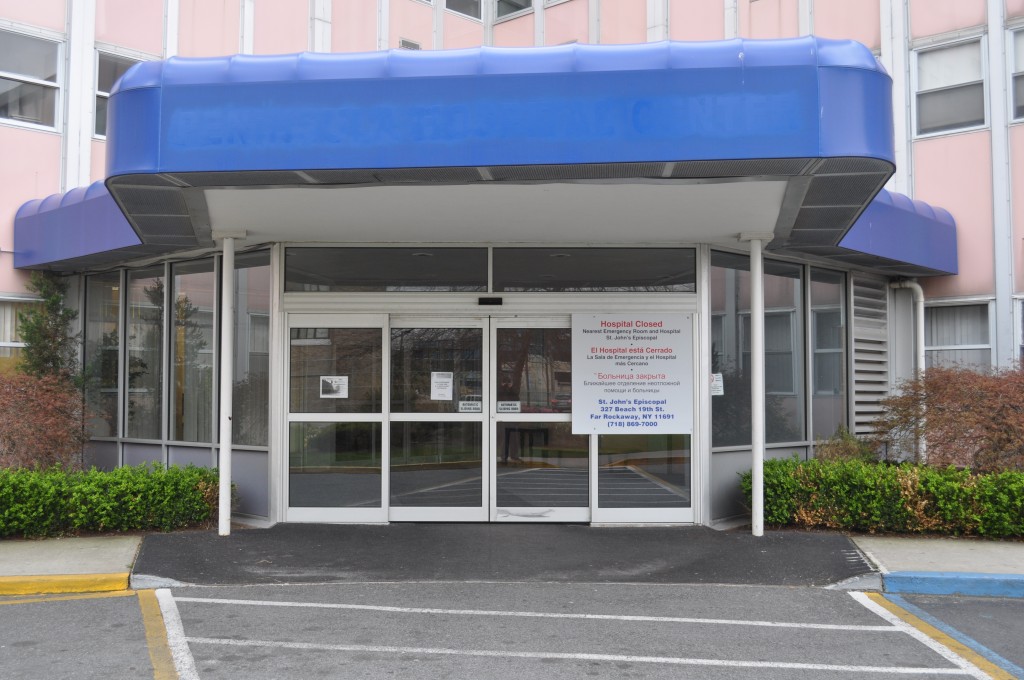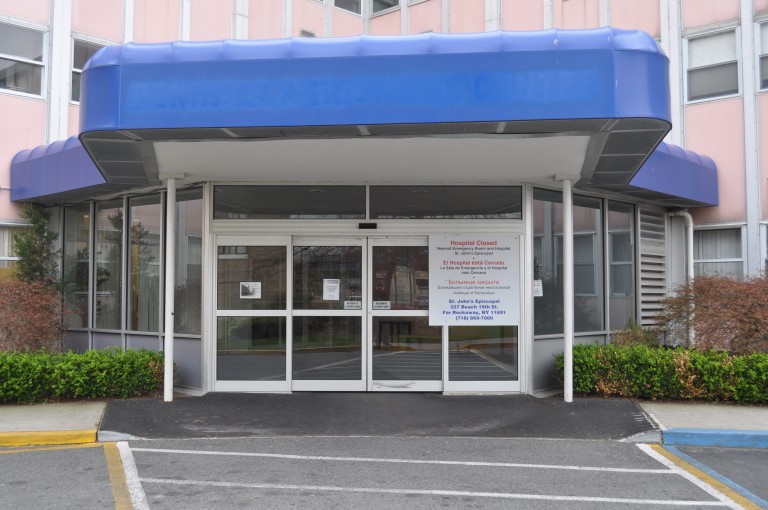
Peninsula Hospital sits abandoned after its April closing. The Rockaway community still mourns its loss and wonders if St. John’s Episcol Hospital will be able to sustain health care needs in the area.
The site of the vacant building on Beach Channel Drive in Far Rockaway that once housed 173 hospital beds still causes residents to shake their head in disbelief. The mere mention of the former facility’s name, Peninsula Hospital Center (PHC), almost always provokes community members, former employees, and politicians alike to angrily question what went wrong in the 107-year-old care facility.
The state Health Department set out to shed light on that perplexity in a four page report they issued last week. It outlines a bleak picture of debilitating financials that triggered Peninsula to make dangerous operational cuts that further exacerbated the problem. The hospital’s inability endure the fiscal turmoil eventually caused the state to revoke the hospital’s operating license last April, forcing the facility to close its doors to 130,000 Far Rockaway residents.
The report, which was a requirement of a public hearing held in May, states the hospital entered into bankruptcy in September of 2011 with more than $60 million in debt, after sustaining four consecutive years of operational losses. The Health Department says the facility was “unable to meet payroll to retain adequate staffing, could not pay vendors providing such services as intravenous fluids, laundry services, operating room supplies or garbage removal. Equipment was not adequately maintained and broken equipment was not fixed or replaced.”
Jonathan Gaska, District Manager of Community Board 14, whose constituents fervently opposed the hospital’s closing, took issue with simple financial blame.
“Most hospitals are barely getting by financially. [Peninsula is] no different than any other metropolitan hospital. But, these other hospitals are able to keep their doors open, meet the needs of their patients,” said Gaska. “The government needs to find a way to keep hospitals [like Peninsula] open.”
The report cites a decline in patient activity as a large contributing factor to the hospital’s financial deterioration. In the past several years, Peninsula suffered as more and more residents, including Medicaid and Medicare patients, sought care in facilities outside of Rockaway.
According to the report, the hospital mainly served three ZIP codes: 11691, 11693 and 11694. These targeted areas accounted for 87 percent of PHC’s total inpatient volume, but only about 20 percent of total patients in these ZIP codes elected to receive care at Peninsula. The average daily inpatient census declined from 118 in 2005 to 72 in 2010 , the report said.
The cash-strapped facility’s financial worries bled into operations when the state Health Department conducted several routine surveys in which they found serious and dangerous deficiencies in the hospital’s clinical lab.
Some of the most worrisome observations made were the discovery of expired reagents, blood platelets that were not consistently stored at the correct temperature, and on one occasion, an employee who had only received two days of training, was left alone to run the blood bank.
As a result, the state suspended laboratory services for 30 days in February of this year. The hospital then was eventually forced to suspend any activities related to these services, including surgeries and admissions, which significantly reduced revenue needed to sustain operations.
Prior to entering into Chapter 11 bankruptcy last fall, Peninsula’s governing body, its board of directors, was already scrambling for a solution to its unrelenting debt. The Health Department says they initially tried to broker a merger with St. John’s Episcopal Hospital, the only other hospital in Rockaway, a little over a year ago, but PHC’s finances rendered the attempt unfeasible.
In July of 2011, the board submitted a closure plan to the state, but later revoked it. Then, in a move that most certainly sealed Peninsula’s path to bankruptcy, Medisys Health Network, which provided many of the hospital’s operational and administrative services, withdrew from their role as the sole corporate member of the board due to the hospital’s unrelenting debt.
Peninsula then filed for bankruptcy and a court-appointed trustee, who was approved by the hospital’s board, was granted financial decision making on the hospital’s behalf. The trustee submitted a plan for closure in early April of this year and by the 9th of the month, the hospital’s doors were closed for good.
Despite the Health Department’s attempt to provide insight into the closure, Congressman Bob Tuner (R-Queens), is unconvinced of the state’s role in trying to resuscitate the Queen’s facility.
“The DOH came into this situation seemingly dead-set on closing the doors of the hospital by any means necessary. I have not seen a single positive step being taken by them to try and save this hospital. They have denigrated any and all attempts to solve this problem. Rather than trying to solve the problems, the DOH became the biggest one,” said Turner in a written statement.
Turner is also skeptical of how the Rockaway community will cope now that only St. John’s remains to serve it.
“The report does little to nothing to address how the state plans to meet the needs of local residents as they move forward. I implore the Health Department to act responsibly and clue local residents in about how they plan to address what could constitute a potential healthcare disaster in the wake of a single storm or any other medical emergency,” Turner stated.
The Health Department says, “There is no perfect prediction as to how populations will respond to a hospital’s closure.” But, in response to concerns voiced at the public hearing that St. John’s does not have the capacity to absorb former Peninsula patients and that the closure of an emergency room can create potential endangerment due to the extra time needed to transport patients, the Health Department says they are granting $5.2 million to expand emergency room services at St. John’s. They additionally say they are directing St. John’s to work with the Adabbo Health Clinic to improve services so they can take on more cases that do not require emergency services.
The bankruptcy trustee is currently in the process of selling Peninsula’s assets including its physical structure.
The report makes no mention of the more than 1,000 people who lost their jobs with the closure which has still left many unsettled.
“[The report] does nothing. It doesn’t make anyone feel better,” said Gaska. “People lost jobs. The state department controlled the lever and made a decision. Residents now have to deal with the decision. It’s frustrating and disappointing, but now we have to work towards St. John’s as good as can be.”
By Katie Riordan

